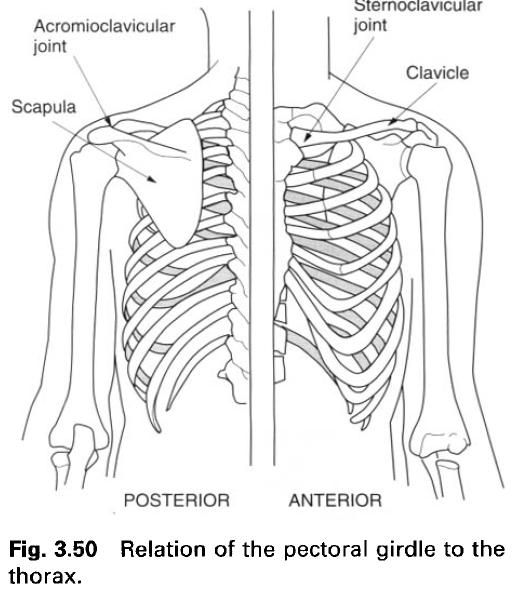The upper limb has become highly specialized in
its functions of prehension and manipulation. Evolutionary forces have produced
a limb which is extremely mobile yet without losing the stability required to
give the acquired mobility, force and precision. The culmination of this
evolutionary development is an upper limb which has no locomotor function,
except in infants and in those who, of necessity, use walking aids.
All vertebrates possess four limbs of one form
to another, these limbs being connected to the axial skeleton by the pectoral
and pelvic girdles. The pelvic girdle is firmly anchored to the vertebral
column, it articulates only with thoracic cage, which while providing a
mechanism whereby forces generated in the upper limb can be partially
transferred to the axial skeleton, it does not unduly restrict movement of the
girdle as a whole.
The shoulder blade(scapula) and clavicle are
the bones of the pectoral girdle. The shoulder blade is usually referred to as
the scapula in descriptive anatomy;
morphologically the term has a slightly more restricted meaning. Although
movements of the shoulder joint accompany nearly all movements of the joints of
the pectoral girdle, it is not part of the pectoral girdle. The shoulder blade is
slung in muscle from the thoracic cage, while the clavicle interposes itself between shoulder blade and thorax
providing a strut which steadies and braces the pectoral girdle during
adduction movements. The clavicle
articulates with the thorax by the sternoclavicular joint, and with the
shoulder blade by the acromioclavicular joint. The humerus of the upper limb joins the scapula at the shoulder(glenohumeral) joint. It is the summation of
the mobility of these three individual, yet mutually interdependent, joints
which gives the upper limb its freedom of movement, consequently, the ultimate
range of movement of the shoulder complex is much greater than that of the hip.
The clavicle moves with respect to
the sternum, the scapula with respect
to the clavicle and the humerus with respect to the scapula. In addition, the scapula moves with respect to the
thoracic wall. This arrangement favours mobility of the shoulder-arm complex;
however, it makes stabilization of the upper limb against the axial skeleton
much more difficult. Stability is achieved by the powerful musculature which
attaches the pectoral girdle to the thorax, vertebral column, head and neck.
Furthermore, this musculature acts as a shock absorber when body-weight is
received by the upper limbs.
Just as the innominate bone consists of three
parts which meet and fuse at the acetabulum, so there are three parts of the
shoulder blade. The broad, flat, dorsal part of the shoulder blade is the scapula; the ventral part is the
coracoid process, the two joining together in the upper part of the glenoid
fossa.( These are counterparts of the ilium and ischium respectively.) A small
piece of bone, the precoracoid, ossifying separately at the tip of the coracoid
process, is the counterpart of the pubis.
The clavicle has no counterpart in the pelvic
girdle. Forces from the upper limb are transmitted by the trapezius to the cervical spine and by the clavicle to the axial skeleton by the coracoclavicular and
costoclavicular ligaments, so that normally neither end of the clavicle transmits much force.











0 коментара:
Постави коментар